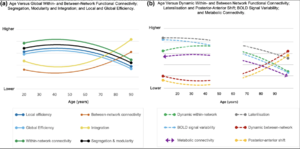Neuroplasticity

As we age, it is difficult to teach the old dog new tricks. This challenge stems from the decline in neuroplasticity, the brain's ability to alter its default state as we age[2]. Despite this natural decline, there's a silver lining – a vast amount of scientific studies have uncovered that psychedelics have the unique ability to temporarily reopen a neuroplastic window, offering a potential avenue for change.

When young, humans are extremely neuroplastic meaning when an experience demands, it doesn't take much effort to change the brains default behaviour. Neuroplasticity declines as we age (see Figure 1)[2][1][4], leading to a more fused brain (see Figure 2)[3]. Recent studies have shown neuroplasticity can be temporarily improved by inducing pivotal mental states via the use of psychedelics.
This decline in neuroplasticity was eloquently described in three points by Douglas Adams reflecting on our relationship with technology:
- Anything that is in the world when you are born is normal and ordinary and is just a natural part of the way the world works.
- Anything that is invented between when you are fifteen and thirty-five is new and exciting and revolutionary and you can probably get a career in it.
- Anything invented after you are thirty-five is against the natural order of things.
Structure-Activity
The brain is neurochemical in nature, meaning it is part electric and part chemical. When these systems combine to provide brain function they work like hiking trails; the pathways that get a lot of traffic get smoother and wider, with brush stomped down and pushed back. The neural pathways that sit unused grow over, becoming less likely to be used. Your brain uses the more accessible pathways as it takes lower energy to do so.
Neuroplastogens
Anti-Neuroplastogens
Caffeine
There is preliminary data[5] highlighting that chronic caffeine use could limit learning or plasticity, including rTMS effectiveness.
References
- ↑ Jump up to: 1.0 1.1 Changes in plasticity across the lifespan: Cause of disease and target for intervention. Publish 10 April 2015, accessed on 3rd March 2022, via https://www.ncbi.nlm.nih.gov/pmc/articles/PMC4392917/. Read an AI summary.
- ↑ Jump up to: 2.0 2.1 Aging-Related Dysfunction of Striatal Cholinergic Interneurons Produces Conflict in Action Selection, Miriam Matamales, Zala Skrbis, Robert J. Hatch, Bernard W. Balleine. Neuron Journal. Accesed on 7th October 2023 via: https://www.cell.com/neuron/pdf/S0896-6273(16)00185-9.pdf
- ↑ Jump up to: 3.0 3.1 The older adult brain is less modular, more integrated, and less efficient at rest: A systematic review of large-scale resting-state functional brain networks in aging. Hamish A. Deery,Robert Di Paolo,Chris Moran,Gary F. Egan,Sharna D. Jamadar First published: 15 September 2022 https://doi.org/10.1111/psyp.14159. Accessed on 4th October 2022 via https://onlinelibrary.wiley.com/doi/10.1111/psyp.14159
- ↑ Molecular aging of the brain, neuroplasticity, and vulnerability to depression and other brain-related disorders. Dialogues in Clinical Neuroscience. Volume 15, 2013 - Issue 1. Etienne Sibille Pages 53-65 | Published online: 01 Apr 2022. Accessed 19th Jun 2022 via https://www.tandfonline.com/doi/full/10.31887/DCNS.2013.15.1/esibille
- ↑ Chronic caffeine consumption curbs rTMS-induced plasticity. Megan Vigne, Neuromodulation Research Facility, TMS Clinic, Butler Hospital, Providence, RI, United States. Department of Psychiatry and Human Behavior, Warren Alpert Medical School of Brown University, Providence, RI, United States. Accessed via: https://www.frontiersin.org/articles/10.3389/fpsyt.2023.1137681/full